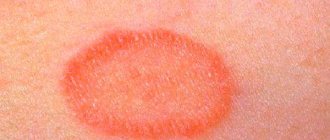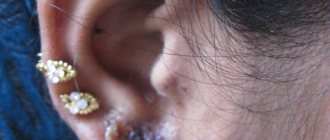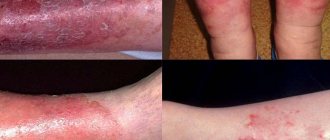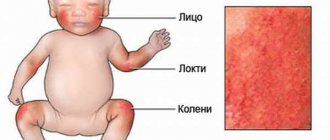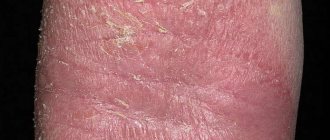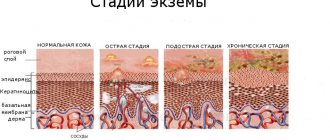Dermatitis is an autoimmune, inflammatory, infectious or other type of damage to the dermal layer. Children, according to medical statistics, suffer from dermatic lesions many times more often. The ratio of young patients to adults is 3:1 and even more (data varies from study to study). There are dozens of forms of the disease, but no more than 5-8 types of the disease are most common. Symptoms are very typical for each type of pathology. What do the types of the disease look like and what manifestations accompany each form?
Dry type
In children, dry dermatitis occurs most often (along with elderly patients). Localized on the legs. This type of dermatitis in a child looks like this:
The photographs clearly show two main forms of dry lesions.
In both situations, a red dot or papule appears, around which a lesion on the leg grows. In the second case, the affected areas are much larger, the entire foot is involved, and there is a diffuse spread of the pathological process (expansive, involving more and more new areas). In this case, it is quite difficult to distinguish dry dermatitis from its atopic form. The feet and skin folds in the ankle area are most often affected .
Additionally, cracking of the skin, peeling, and redness are noted. Subjectively, itching and burning are felt.
Atopic (allergic) type
Due to the characteristics of the immune system, it occurs more often in children. Localized on the legs, face (mostly), and body. The photograph shows a massive facial lesion.
The following photos of dermatitis in children characterize the involvement of the body and legs in the pathological process.
All three photos show typical symptoms of an atopic, allergic form. This is a massive lesion with the appearance of pronounced red spots covered with a crust (keratosis), peeling of the dermal layer. The silvery skin scales and deep cracks are clearly visible.
All these signs distinguish atopic dermatitis from its other forms when visually assessing the condition of the tissues. Differential diagnosis with psoriasis is required.
As can be seen in the photo, there are no plaques characteristic of psoriatic lesions, and ulcers are also not typical.
Atopic dermatitis
Atopic dermatitis in children belongs to a group of diseases that are inherited. The first signs of the disease appear in childhood (up to 10 years), manifestations later than this period are unlikely.
Main symptoms of the disease:
- dryness and severe skin itching, redness, swelling, spots with blurred boundaries;
- scratching causes erosion;
- when infection occurs, suppuration appears;
- usually localized on the inside of the elbows, knees, temples, neck, collarbone, buttocks, and thighs.
The disease is characterized by periods of calm and active manifestation of symptoms. A reaction can occur to any allergen: dust, pollen, household chemicals, etc.
Atopic dermatitis in infants
In infants, the disease manifests itself as redness, dryness and flaking of the skin (mainly in the area of the cheeks and buttocks). Lack of treatment leads to an increase in the affected area, the appearance of ulcers, itching, and provokes the proliferation of bacteria and fungi.
Treatment of atopic dermatitis:
- Clothes made from natural fabrics. Pay special attention to washing powders and other household chemicals; they often contain allergens.
- Antihistamines: Suprastin, Tavegil, Claritin.
- Ointments and creams to moisturize the skin and relieve inflammation.
- Compliance with personal hygiene rules.
- When breastfeeding, a special diet for the mother. The kids' menu includes porridge and vegetable purees.
Interesting to know! There is a treatment method based on introducing doses of the allergen into the body in order to increase its resistance over time. Starting with small doses, the body is allowed to get used to the allergen.
The best way to moisturize the skin is with emollients for atopic dermatitis. Fatty products contained in cosmetics are called emollients. They facilitate easy distribution of the cream over the skin and prevent moisture from evaporating from the surface of the skin.
The most common and available emollients:
- Mustella Stelatopia;
- Emolium;
- Topicrem;
- Locobase;
- La Roche Posay Lipikar.
The main mistake parents make is to stop applying the cream to the child’s body when the disease is in a quiescent stage.
Seborrheic type
Localized on the head (scalp, forehead).
Children often suffer from the seborrheic type of disease, and due to the sparseness of hair, the main signs of the disease are clearly visible.
As follows from the photo, the head in the area of the scalp and forehead is covered with yellowish scaly plaques, which are characterized by keratosis (dryness), intense peeling and death. This is a typical clinical picture of seborrheic dermatitis, which distinguishes it from other forms of dermatitis in children .
Additionally, eyebrows, forehead, and temples may be involved in the process. At the initial stages, the plaques are small, then they grow and form scattered lesions that do not merge together (visible in the photo and again distinguishes seborrheic dermatitis). Localization is also typical.
Contact dermatitis
Otherwise called diaper. Contact dermatitis is a type of atopic disease.
The photo clearly shows typical manifestations of the allergic form of pathology:
- redness;
- peeling;
- cracks;
- keratosis;
- inflammation.
The location of the pathological process is strictly delimited . Small spots may appear on the body, thighs, abdomen, arms, and buttocks (as a result of wearing diapers). This is not an axiom. Sometimes the contact type is difficult to distinguish from the classic atopic type.
Causes of allergic dermatitis in children
Allergens enter the body in the following ways:
- Contact dermatitis:
- wet diapers: rashes appear in places where the baby is in constant contact with a wet diaper - the back, buttocks, stomach and groin area;
- untimely change of diaper: provokes a rash and redness in the groin, between the buttocks and on the stomach;
- synthetic materials: clothing and bedding cause irritation in those areas of the body with which there is direct contact;
- children's cosmetics (cream, soap, shampoo): children's delicate skin is sensitive. It is important to choose the right special moisturizer without additives;
- household chemicals, perfumes;
- polluted air: dusty and polluted air in industrial cities complicates the life of an allergy sufferer.
- Toxicodermic dermatitis. Toxicoderma is caused by external factors:
- food;
- traffic fumes;
- medicines;
- infections;
By limiting irritants and allergens, eighty percent of children experience a reduction in the frequency of exacerbations.
Perioral dermatitis
It is formed as a result of exposure to aggressive substances in the perioral cavity. This form also develops when using nipples, creams, and infant formula. The photo shows all the characteristic symptoms of the disease, the localization is more than typical. This is the perioral region radially surrounding the lips.
The next photo shows that pathology may develop in the nasal area.
Moreover, the child does not always develop only spots.
The hallmark of perioral dermatitis in younger patients is the appearance of vesicles-papules, which are filled with yellowish liquid or pus . This is clearly noted in both photographs.
Treatment of allergic dermatitis in children
Allergy treatment begins with identifying the pathogen and allergen. To do this you need to undergo an examination. Based on the results, individual therapy is prescribed according to the patient’s age. The very first thing for a positive result is to eliminate contact with the irritant.
Drug treatment
Drug treatment is carried out as follows:
- First of all, you should alleviate the baby’s condition and relieve the symptoms that lead to unbearable itching. Medicines prescribed by your doctor will help eliminate the symptoms. For example, “Tavegil”, “Claritin”, “Zyrtec”, “Claritidin”. Activated carbon tablets will help prevent possible intoxication.
- The skin is treated with ointments: Akriderm, Sinaflan, Celestoderm; it is important to note that these ointments contain hormones and are used exclusively in severe cases. To reduce the intensity of the allergic reaction, it is recommended to use non-hormonal agents: “Keratolan”, “Radevit”, “Vitamin F 99”.
Akriderm ointment successfully treats allergic dermatitis. Here you can see the instructions for using Akriderm ointment and what it helps with.
Doctors do not recommend using the drug for a long time on the same affected area, which can lead to a negative effect. You cannot self-medicate. Treatment is prescribed only by a qualified doctor based on the results of the examination.
Diet
Diet plays an important role in treating any allergy. It is necessary to completely exclude allergenic foods from the diet: honey, citrus fruits, strawberries, nuts, tomatoes, chicken eggs, cow's milk and those that contain added food coloring.
They are replaced with products with a significant content of vitamins, which strengthen the immune system of the little patient. If a baby with allergies is breastfed, then the mother follows the diet.
The mixture for feeding an allergic person must be strictly selected by a doctor. If it is impossible to consume cow protein, it is replaced with soy or goat protein. If the body reacts negatively to any type of milk protein, it is important to introduce therapeutic nutrition - a mixture based on hydrolyzed protein. Complementary feeding from fruit puree should be introduced no earlier than 10 months; it is recommended to prepare it at home.
The product in jars often causes allergies. Such children should not include yolk, fish, or fatty meat in their complementary foods. It is better to wait with them until the baby is two years old. It is at this age that the body develops and is more resistant to certain allergens.
Kefir and low-fat cottage cheese are allowed among dairy products. Dietary meat - turkey, rabbit, chicken fillet - steamed or baked. Completely exclude baked goods, smoked meats, preserves, sweets, chocolate, and exotic fruits.
Hypoallergenic life
To treat dermatitis, you need to adhere to the following rules in everyday life:
- All baby clothes and bedding should be made only from natural fabrics - cotton, linen, viscose. Items made of wool should not come into direct contact with the skin.
- The air in the children's room should have high humidity.
- Eliminate or minimize contact with pets.
- Daily wet cleaning of premises without the use of chemicals.
- Individual hypoallergenic products for baby hygiene.
- Be careful when choosing diapers.
Fungal dermatitis
Develops mainly in little girls. Localized in the genital area and on the legs.
The photo shows bright red rashes, pronounced hyperemia of the skin and external genitalia, and the formation of yellowish crusts. This is why fungal dermatitis differs from all other types.
The triad of symptoms should alert parents:
- severe hyperemia (raspberry skin color);
- damage to the genital organs;
- the formation of yellowish crusts or papules filled with purulent exudate.
A whitish coating may form on the skin with an unpleasant, sourish-putrid odor.
This type of disease is treated by dermatologists together with infectious disease specialists.
Doctor Komarovsky about allergic dermatitis in a child
According to Komarovsky, it’s rare that a baby gets along without redness on the cheeks and inflammatory spots on the skin. Diathesis has a complex mechanism of occurrence.
The doctor believes that it is possible to significantly reduce allergies or get rid of them altogether if:
- reduce sweating;
- prevent the allergen from getting inside and being absorbed into the blood;
- avoid direct skin contact with external irritants;
- control of drinking enough fluid;
- reduce layers of clothing and blankets;
- maintain ideal humidity (55 - 60%) and comfortable (18-20 degrees) indoor air temperature.
He identifies the causes of allergies that contribute to its exacerbation:
- The presence of an allergen in the external environment, in contact with the child’s skin, reacts with sweat;
- Intense sweating;
- Ingestion of an allergen, the breakdown products of which are absorbed into the blood from the intestines.
It is typical that provocateurs are simple things that do not harm health. Why do some children’s immune system adequately perceive these substances, while others do not?
Komarovsky’s method identifies two factors:
- Early age, when immunity is not fully formed;
- Excess antigen.
The doctor believes the main reasons are:
- External allergen that interacts with the skin. These include: wool; pollen; dust; chemical substances; cosmetics.
- Internal antigen that enters the intestines with food. These include food, drinks, and medicines.
Infectious dermatitis
In children, a similar form occurs against the background of a weakened immune system of the body. Characteristic are generalized lesions of the dermis involving the scalp, face, body, arms and legs in the pathological process. Another process is also possible when the dermal lesion covers only certain areas of the skin at the site of penetration of the virus or bacteria. The photographs show the characteristic signs of this disease.
These are large areas of destruction of the skin with the formation of pronounced crusts, deep ulcers, and a dark color of the dermis. This is the so-called eczematous rash, it is difficult to treat. The use of antibiotics and other means is necessary.
These are the main types of disease that occur in children. The remaining types of lesions develop extremely rarely; the described types account for about 98% of clinical situations.


